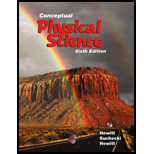
Conceptual Physical Science (6th Edition)
6th Edition
ISBN: 9780134060491
Author: Paul G. Hewitt, John A. Suchocki, Leslie A. Hewitt
Publisher: PEARSON
expand_more
expand_more
format_list_bulleted
Concept explainers
Question
Chapter 13, Problem 54E
To determine
The reason for the Carbon-14
Expert Solution & Answer
Want to see the full answer?
Check out a sample textbook solution
Students have asked these similar questions
Pls help ASAP
Pls help ASAP
Pls help ASAP
Chapter 13 Solutions
Conceptual Physical Science (6th Edition)
Ch. 13 - Prob. 1RCQCh. 13 - What is the origin of most of the natural...Ch. 13 - Which produces mote radioactivity in the...Ch. 13 - Prob. 4RCQCh. 13 - Prob. 5RCQCh. 13 - Prob. 6RCQCh. 13 - What role do neutrons play in the atomic nucleus?Ch. 13 - Prob. 8RCQCh. 13 - Prob. 9RCQCh. 13 - What is the long-range fate of all the uranium...
Ch. 13 - What is meant by the half-life of a radioactive...Ch. 13 - What is the half-life of uranium-238?Ch. 13 - What happens to a nitrogen atom in the atmosphere...Ch. 13 - Prob. 14RCQCh. 13 - Prob. 15RCQCh. 13 - Prob. 16RCQCh. 13 - Prob. 17RCQCh. 13 - Prob. 18RCQCh. 13 - Prob. 19RCQCh. 13 - Prob. 20RCQCh. 13 - Prob. 21RCQCh. 13 - How does the mass per nucleon in uranium compare...Ch. 13 - How does the mass of a pair of atoms that have...Ch. 13 - Prob. 24RCQCh. 13 - What kind of nuclear power is responsible for...Ch. 13 - Throw ten coins onto a flat surface. Move aside...Ch. 13 - Repeat the above, but use 10 dimes and 25 pennies....Ch. 13 - Consider a radioactive sample with a half-life of...Ch. 13 - Uranium-238 absorbs a neutron and then emits a...Ch. 13 - Rank the following three types of radiation by...Ch. 13 - Prob. 35TARCh. 13 - Rank the following isotopes from the most...Ch. 13 - Rank the following in order from the most energy...Ch. 13 - Prob. 44ECh. 13 - Which should be more stable: the lithium-5 or the...Ch. 13 - Which should be more stable: the lithium-7 or the...Ch. 13 - Why is lead found in all deposits of uranium ores?Ch. 13 - Prob. 48ECh. 13 - Elements heavier than uranium in the periodic...Ch. 13 - If you make an account of 1000 people born in the...Ch. 13 - What do the proportions of lead and uranium in...Ch. 13 - Radium-226 is a common isotope on Earth, but it...Ch. 13 - Prob. 53ECh. 13 - Prob. 54ECh. 13 - Prob. 55ECh. 13 - Prob. 56ECh. 13 - Prob. 57ECh. 13 - Why is carbon better than lead as a moderator in...Ch. 13 - Prob. 59ECh. 13 - Prob. 60ECh. 13 - Prob. 61ECh. 13 - How does the mass per nucleon in uranium compare...Ch. 13 - Prob. 63ECh. 13 - Prob. 64ECh. 13 - Prob. 65ECh. 13 - Prob. 66ECh. 13 - Prob. 67ECh. 13 - Prob. 68ECh. 13 - Prob. 69ECh. 13 - Prob. 70ECh. 13 - Prob. 71ECh. 13 - Prob. 72ECh. 13 - Prob. 73ECh. 13 - Prob. 74ECh. 13 - Prob. 75ECh. 13 - Prob. 1RATCh. 13 - Prob. 2RATCh. 13 - A sample of radioactive material is usually a...Ch. 13 - What evidence supports the contention that the...Ch. 13 - When the isotope bismuth-213 emits an alpha...Ch. 13 - If uranium were to split into 90 pieces of equal...Ch. 13 - Prob. 9RATCh. 13 - If an iron nucleus split in two, its fission...
Knowledge Booster
Learn more about
Need a deep-dive on the concept behind this application? Look no further. Learn more about this topic, physics and related others by exploring similar questions and additional content below.Similar questions
- Pls help ASAParrow_forwardPls help ASAParrow_forwardFind the integral expression for the magnetic force on a wire carrying 3.5 amps current on the z axis with length2 meters on end at the origin and the other at z=4. Magnetic field is B = 4(zy+4) i - (z-3) j + 20(x+2)/(z-3) k.Don’t take the integral. Integral should contain only x-y-z as variables not rarrow_forward
arrow_back_ios
SEE MORE QUESTIONS
arrow_forward_ios
Recommended textbooks for you
 Modern PhysicsPhysicsISBN:9781111794378Author:Raymond A. Serway, Clement J. Moses, Curt A. MoyerPublisher:Cengage Learning
Modern PhysicsPhysicsISBN:9781111794378Author:Raymond A. Serway, Clement J. Moses, Curt A. MoyerPublisher:Cengage Learning Principles of Physics: A Calculus-Based TextPhysicsISBN:9781133104261Author:Raymond A. Serway, John W. JewettPublisher:Cengage Learning
Principles of Physics: A Calculus-Based TextPhysicsISBN:9781133104261Author:Raymond A. Serway, John W. JewettPublisher:Cengage Learning College PhysicsPhysicsISBN:9781305952300Author:Raymond A. Serway, Chris VuillePublisher:Cengage Learning
College PhysicsPhysicsISBN:9781305952300Author:Raymond A. Serway, Chris VuillePublisher:Cengage Learning University Physics Volume 3PhysicsISBN:9781938168185Author:William Moebs, Jeff SannyPublisher:OpenStax
University Physics Volume 3PhysicsISBN:9781938168185Author:William Moebs, Jeff SannyPublisher:OpenStax College PhysicsPhysicsISBN:9781285737027Author:Raymond A. Serway, Chris VuillePublisher:Cengage Learning
College PhysicsPhysicsISBN:9781285737027Author:Raymond A. Serway, Chris VuillePublisher:Cengage Learning College PhysicsPhysicsISBN:9781938168000Author:Paul Peter Urone, Roger HinrichsPublisher:OpenStax College
College PhysicsPhysicsISBN:9781938168000Author:Paul Peter Urone, Roger HinrichsPublisher:OpenStax College

Modern Physics
Physics
ISBN:9781111794378
Author:Raymond A. Serway, Clement J. Moses, Curt A. Moyer
Publisher:Cengage Learning

Principles of Physics: A Calculus-Based Text
Physics
ISBN:9781133104261
Author:Raymond A. Serway, John W. Jewett
Publisher:Cengage Learning

College Physics
Physics
ISBN:9781305952300
Author:Raymond A. Serway, Chris Vuille
Publisher:Cengage Learning

University Physics Volume 3
Physics
ISBN:9781938168185
Author:William Moebs, Jeff Sanny
Publisher:OpenStax

College Physics
Physics
ISBN:9781285737027
Author:Raymond A. Serway, Chris Vuille
Publisher:Cengage Learning

College Physics
Physics
ISBN:9781938168000
Author:Paul Peter Urone, Roger Hinrichs
Publisher:OpenStax College